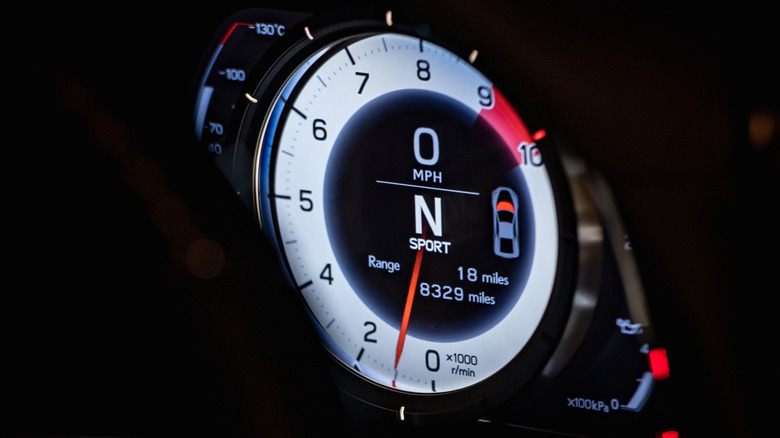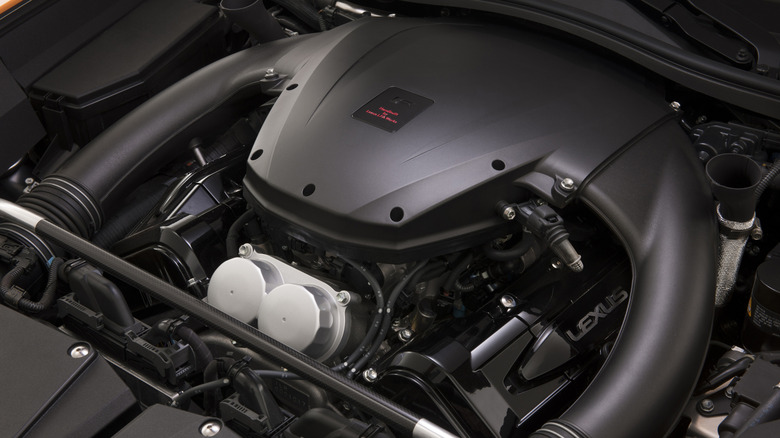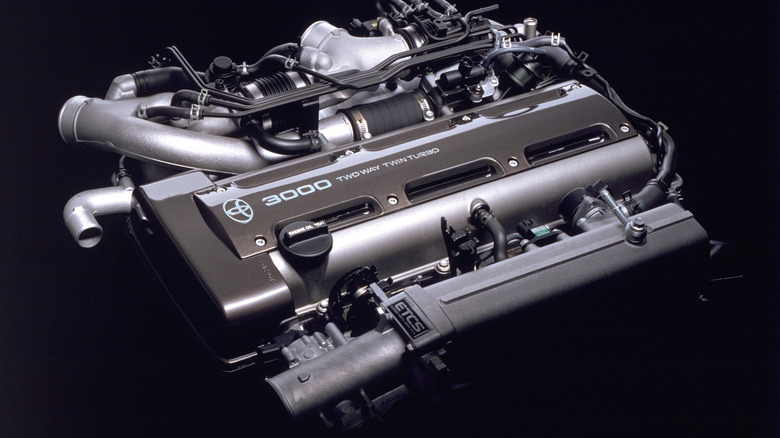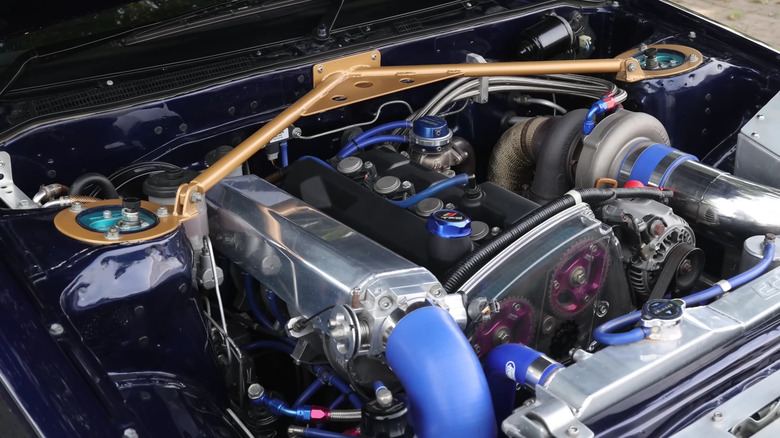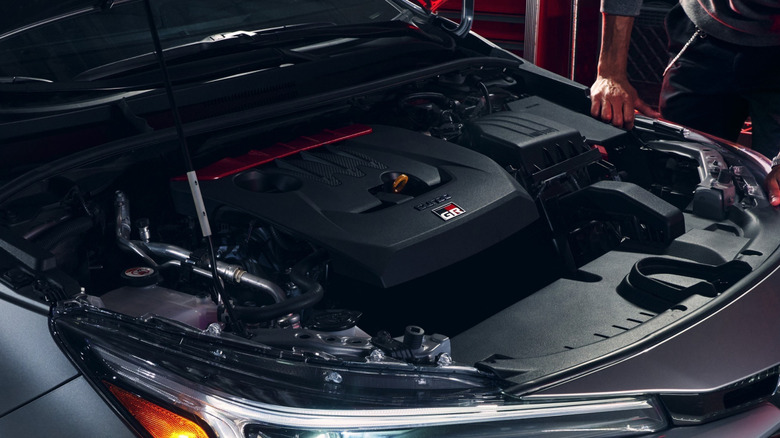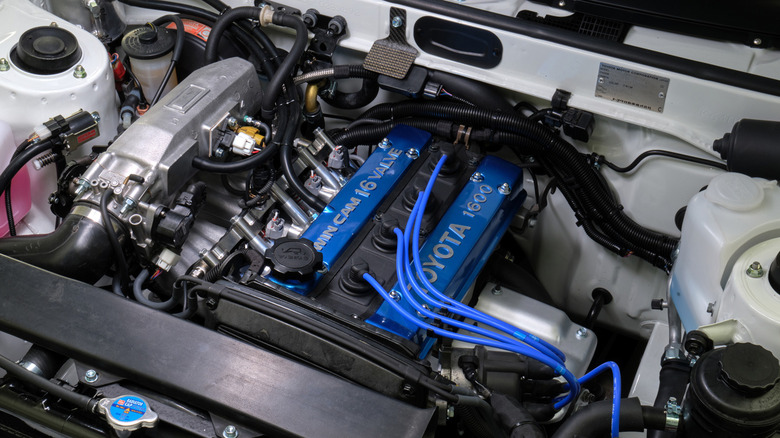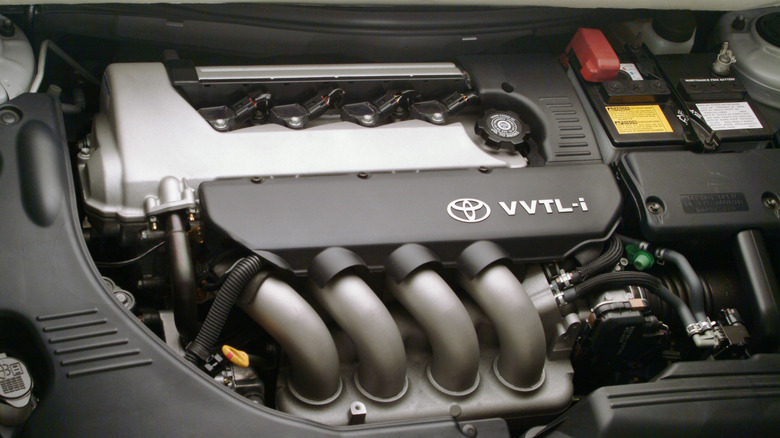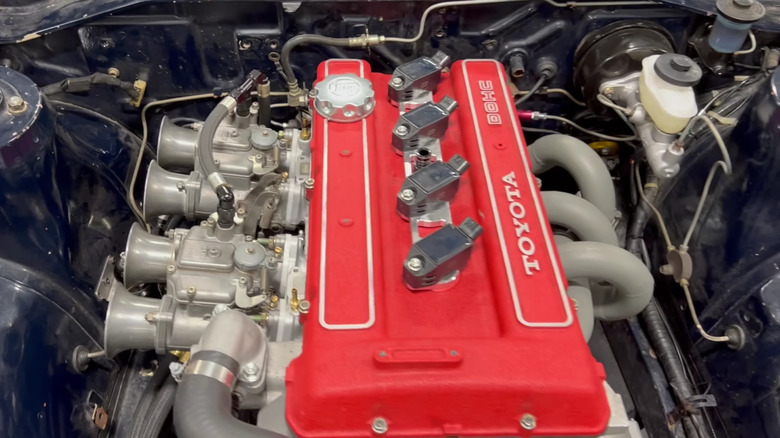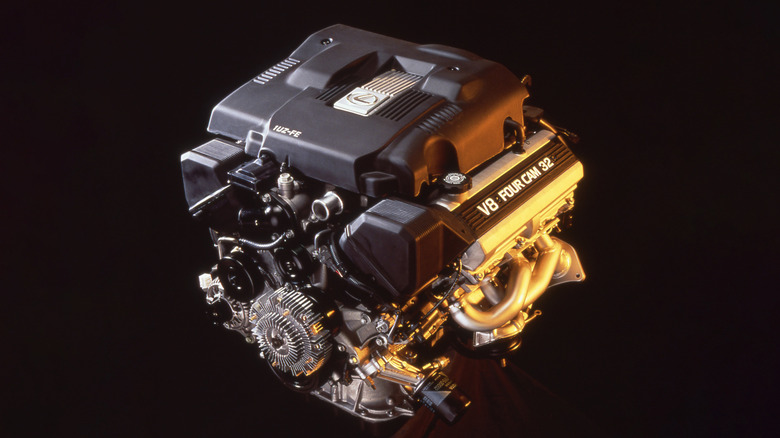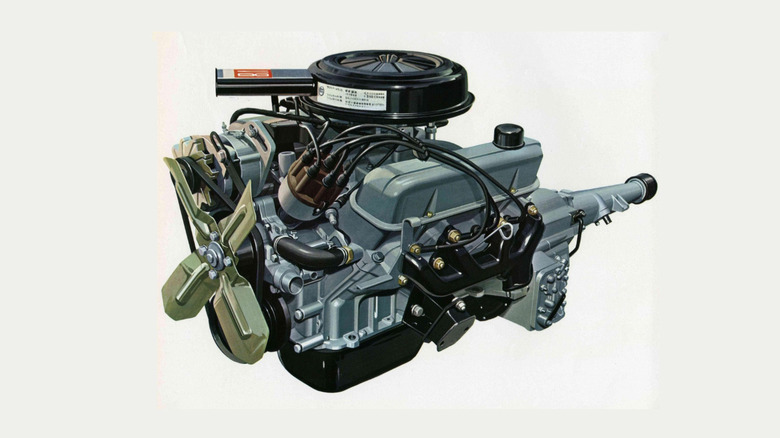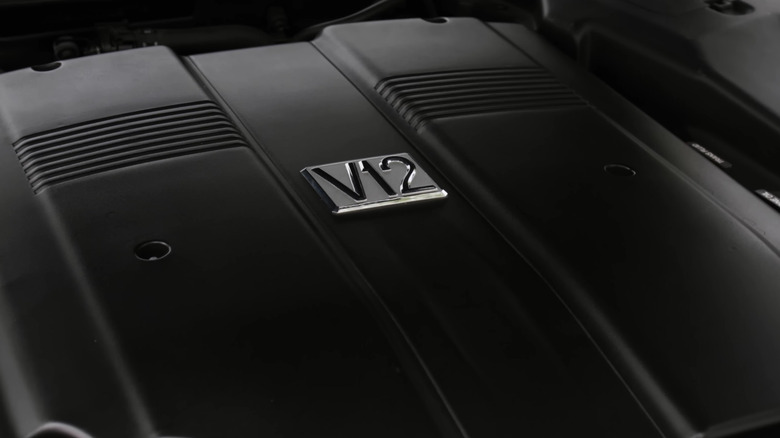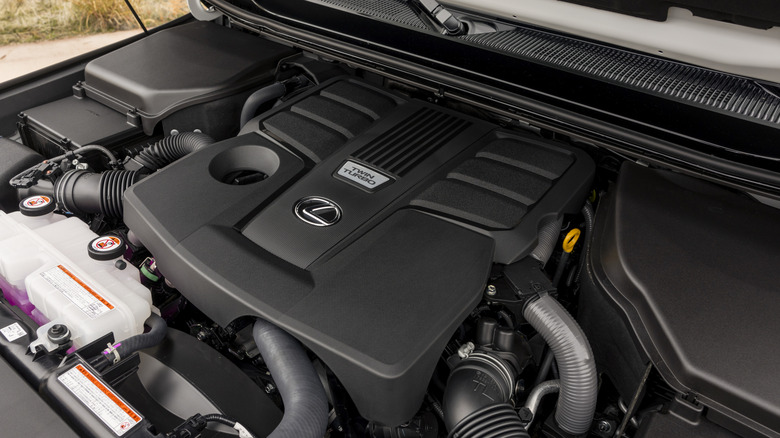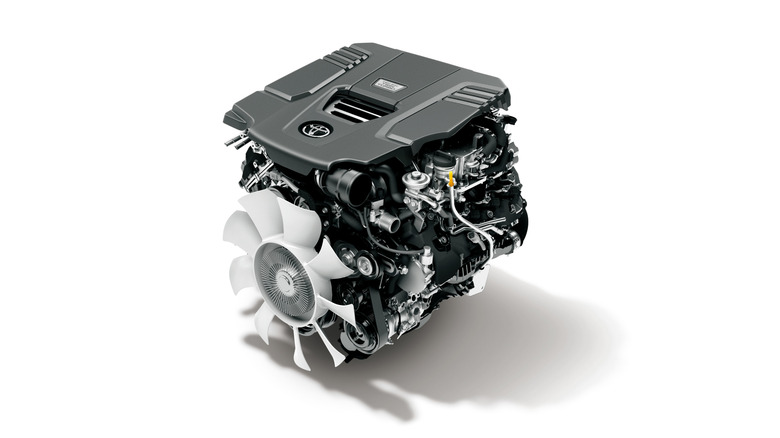12 Of The Most Impressive Toyota Engines Ever Built
The Toyota Motor Corporation has been one of the most important players in the automotive industry for over seven decades. During that time, it established itself as a manufacturer of reliable and efficient cars, a leitmotif that follows the brand today. The world's biggest automaker is also known for pushing the envelope with new, advanced technologies.
A big part of that has always been its engines; Toyota's internal combustion wonders might not carry the cachet of Honda's, but you'll still need more than a few pairs of hands to count all the legendary motors the company has built: High revving delights, twin-turbocharged beasts and even super-smooth luxury machines. Toyota has produced every type of engine you could imagine, and then some. This is hardly surprising, as its portfolio includes everything from small city cars to 230-mph Land Cruisers that break Guinness speed records.
In this piece, we'll give you only the most impressive Toyota engines ever built. These highly engineered machines broke new ground with technological innovation, expanding Toyota's reach in multiple categories, from small sports cars to huge luxury cruisers. Most of them also gained the legendary perk and still entice automotive enthusiasts today.
1LR-GUE
There is no way this list would've started with any other engine. The naturally aspirated 4.8-liter V10 masterpiece from the Lexus LFA was immortalized time and again for its free-revving nature, reminiscent of racing engines, and the otherworldly noise it produces. Like, even 15 years after LFA's launch, the 1LR-GUE is widely considered as the best sounding engine ever made.
You are probably smirking by now, pointing out that Yamaha played a huge role in the design. You would be right — Yamaha's engineers were behind that fantastic noise, in fact. Their know-how in high-revving motorcycle engines also allowed LFA's V10 a 9,000 redline. It only needed 0.6 seconds to reach that figure from idle.
The Lexus LFA V10 engine is truly special, and gets more extraordinary in an era where electrification has took the soul of the internal combustion engine. Check this out: Titanium alloy conrods and valves. Dry sump lubrication. Lightened crankshaft. Magnesium alloy cylinder head covers. Solid rocker arms with diamond-like wear resistance coating. Forged pistons. A high 12:1 compression ratio. These things will forever be exotic.
The engine's figures are also outstanding; 553 horsepower at 8,700 rpm and 354 lb-ft of torque at 6,800 rpm. More importantly, 90% of the torque is available between 3,700 and 9,000 rpm — no turbo lags — just warp-speed response. As a result, the LFA reached 62 mph (100 km/h) in just 3.6 seconds, and a top speed of 202 mph.
2JZ-GTE
Before LFA's V10 engine enamored enthusiasts with its visceral nature, Toyota's highest-performing engine was the 2JZ-GTE. Another legend in the automotive world, this 3.0-liter twin-turbo inline-6 monster is special because of its potential. Sure, with stock 320 horsepower at 5,600 rpm and 315 lb-ft of torque at 4,000 rpm, it's already potent, but its tunability is off the charts. You can get almost 2,000 horsepower from the 2JZ-GTE and smoke most cars on the drag strip. For a rear-wheel-drive grand tourer, that's frankly absurd.
We can only guess why the 2JZ-GTE is so overbuilt, but it comes from an era when Toyota was ranking record-high profits. It didn't come from racing, as the 2JZ-GTE was designed for road use only. Still, the engine features a stout, closed deck iron block, forged rods, forged crankshaft, and cast, but very strong pistons. Consequently, it's one of the most reliable performance engines ever made.
The 2JZ-GTE also has sequential turbochargers, i.e., a smaller one for low rpm torque boost and a larger one for high horsepower. Back in the 1990s, this setup was considered exotic. The best part — you can maximize the potential of these turbos by simply boosting the pressure. Or you can replace them; this is quite straightforward, though, with twin-turbo kits available from various aftermarket vendors, allowing a hike to 450 horsepower. You can also go the single-turbo route which would extract more horsepower at higher rpm, but creates quite the turbo lag. Crucially, the choice is there.
3S-GTE
As much as the 2JZ-GTE is praised in enthusiast circles, the 3S-GTE is perhaps undervalued. Unlike its bigger brother, this 2.0-liter turbocharged four-cylinder also has motorsport dominance under its belt. From Group C to IMSA GTP, the 3S-GTE was a force to be reckoned with during the 1980s and 1990s. It even powered the first Smokey Nagata Toyota Supra, and Castrol Tom's Supra in the All-Japan GT championship, replacing the stock 2JZ-GTE.
However, the 3S-GTE was used in many other Toyota sports cars as well. It was part of the Toyota Celica GT-Four homologation specials, second-gen MR2, and Caldina GT-Four. In its most potent fourth and fifth-gen configuration, the 3S-GTE made 260 horsepower at 6,200 rpm and 239 lb-ft of torque at 4,400 rpm. This would be impressive for a 2.0-liter four-cylinder even today, let alone one produced in 1999.
It's not the power figures that make this engine impressive. It's also a stout and reliable engine that responds well to high-horsepower builds. That's hardly surprising, as it also features a cast iron block, forged crankshaft, forged rods, and aluminum pistons. Toyota also threw every advanced technology it had onto later versions, like Dual VVTi, making it a Breakthrough Engine with an Advanced Mechanism System (BEAMS) engine. The last fifth-gen version even got huge 35-mm titanium valves — that's how serious the Japanese automaker was in extracting performance from the 3S-GTE.
G16E-GTS
You'd think that in an era when most of its cars are hybrids, Toyota would've forgotten about heavily boosted engines. With Akio Toyoda in charge, anything is possible, including a crazy 300-horsepower three-cylinder engine. With a capacity of only 1,618 cm3, this is the most power-dense Toyota engine ever produced. It also powers three very exciting AWD pocket rockets — the rally-inspired GR Yaris, GR Corolla, and Lexus LBX Morizo RR. In the GR Corolla, it's potent enough for a 0-60 time of 4.9 seconds.
However, what makes the G16E-GTS so good is its racing-derived design sprinkled with Gazoo Racing magic. Although small, it follows in the footsteps of the 2JZ-GTE and 3S-GTE with advanced stock internals, like lightweight pistons, high-strength forged connecting rods, forged crankshaft, hollow camshaft, piston skirts with low-friction surface coating, D-4ST Port injection (PI) & Direct injection (DI), and a high 10.5:1 compression ratio. The three-piece aluminum block is also strengthened with a bearing girdle, and there is even a factory-installed water-cooled oil cooler. The G16E-GTS features one single-scroll turbocharger, which, along with the wastegate, is integrated into the exhaust manifold to minimize turbo lag.
All this sounds super impressive until you realize that this teeny-tiny three-cylinder also loves tuning. You can unlock more power with easy modifications, like valve springs, valvetrain, intake, exhaust, camshaft, and turbocharger. Aftermarket tuners are already getting over 700 horsepower from this gem. The G16E-GTS undoubtedly radiates three-cylinder 2JZ vibes.
4A-GE
Toyota wasn't a stranger to small, feisty engines before the G16E-GTS. One of its most popular engines among enthusiasts is the 4A-GE — a rev-happy 1.6-liter four-cylinder that sounds like a racecar engine and has a response that turbocharged powertrains could only dream of. It's very powerful for a naturally aspirated engine as well, producing up to 167 horsepower in the 20-valve Black Top, with an 8,000-rpm redline to boot.
Just like any impressive Toyota engine, the 4A-GE leaves room for upgrades. For instance, this buzzy four-cylinder has been used extensively in the Formula Atlantic racing series, where it made 250 horsepower and revved to astronomical 11,000 rpm. Fun fact — Formula Atlantic 4A-GEs are popular as swaps for the Toyota AE86, the car that made this engine popular in the first place. You can also tune a stock 4A-GE with individual throttle bodies, new cams, and stroker camshaft to bring it to similar power figures. The aftermarket support is still outstanding, so finding parts should be a breeze, too.
Simple in design by today's standards, the 4A-GE was also very advanced in stock form, especially since it mostly powered Toyota budget-friendly sports cars. Four (later five) valves per cylinder. Forged crankshaft and strong OEM pistons. T-VIS (Toyota Variable Induction System) later replaced by VVT with a light flywheel and a short stroke design, enabling high-rpm shenanigans. There was even a supercharged 4A-GZE version with up to 180 horsepower and a useful 155 lb-ft of torque.
2ZZ-GE
Toyota wasn't going to watch Honda perfect the naturally aspirated formula with engines like the B18, and in 1999, launched the brand-new 2ZZ-GE engine. This 1.8-liter unit shared many of the parts with the 1ZZ-FE VVT-i — a more mundane version that powered the Corolla, Matrix, MR2, and Celica.
However, thanks to the addition of VVTL-i, developed together with Yamaha, the 2ZZ-GE added valve lift adjustment to the variable valve timing and duration, producing up to 190 horsepower. This was Toyota's version of Honda's VTEC, allowing a stratospheric 8,200-rpm redline. Oh, and it also had that traditional power boost once the valve lift kicked in (above 6,000 rpm). As you can imagine, driving the 2ZZ-GE enthusiastically required kissing the red line constantly. That was part of the fun, though, as the 2ZZ-GE paired exclusively with a six-speed manual, like in the America-bound Celica GT-S and Corolla XRS.
Still, 2ZZ-GE's rise to the pantheon of greats was its installment in Lotus' featherlight sports cars — the Elise and Exige. Initially, Lotus installed the regular naturally aspirated version, which propelled the 1,929-pound Exige Series 2 to 62 mph in just 5.2 seconds. Later, though, Lotus supercharged and intercooled Toyota's high-revving unit. As a result, in the Exige S 260 Sport, it made 257 horsepower at 8,000 rpm. Torque was also up from 133 lb-ft to 174 lb-ft. 0-60: 4.3 seconds.
18R-G
One of Toyota's first twin-cam engines, the 2.0-liter 18R-G was the brand's enthusiast-oriented four-cylinder machine in the 1970s. It famously powered the first-gen Celica, where it made up to 145 horsepower (JDM-only). As a result, according to Toyota, the small sports car could reach 127 mph — an impressive feat for the time, especially since the Celica was a budget-oriented sports car. It also sounded like a race-car engine, unlike all of today's modern four-cylinder engines.
The 18R-G borrowed the valve gear from the 2.0-liter inline-6 3M engine used in Japan's first supercar, the Toyota 2000 GT. It also had two valves per cylinder, dual Weber carburetors, and a relatively high 9.7:1 compression ratio. However, later models used fuel injection and smog control to meet pollution standards, which dropped the output to 120 horsepower.
Still, with all restrictions lifted and a 16-valve head, the 18R-G was capable of up to 240 horsepower. Toyota competed with this version in world rally events, but private European Formula racers also used it.
1UZ-FE
Toyota was already a force to be reckoned with during the 1980s, with its Corolla often being the world's best-selling vehicle. However, to truly conquer the automotive industry, the Japanese giant needed a competitor to Mercedes-Benz and BMW. In 1989, it launched the Lexus brand with the LS 400. The concept — to build the world's best luxury car.
Powering this car was the special Lexus 1UZ-FE engine — an overengineered all-aluminum 4.0-liter V8 with advanced tech and unmatched reliability. To say that this engine trumped its competitors would be an understatement. It had four valves per cylinder in DOHC configuration. Forged steel crankshaft. Forged steel connecting rods with induction-hardened pins. Reinforced block with cast-iron cylinder liners and six cross-bolted main bearing caps. Hypereutectic aluminum pistons. You know, exotic parts that you mostly see in racing engines. It was also tested for over 1.67 million miles before it entered production to meet Toyota's stringent reliability standards.
The 1UZ-FE was lightweight but also very sturdy and durable. It was satisfactory in the performance department, too, with the later VVT-i version producing 300 horsepower and 310 lb-ft of torque. However, the central theme here was refinement. Compared to six other luxury cars, the 1UZ-FE had eight counterweights on its crankshaft. Heck, the engine was even sitting on liquid-filled mounts to reduce vibrations. Predictably, it was smoother than any V8 at the time; in Top Gear's 1990 review, it didn't even disturb a glass of water when revved to 6,000 rpm.
V
Although the most popular, the 1UZ-FE wasn't Toyota's first V8 engine. For that, we'll need to go back to 1963, when Toyota launched the Crown Eight — its first true luxury sedan. Based on the regular Crown, this larger sedan needed a V8 engine to compete in Japan's luxury segment.
As a result, Toyota developed an all-new "V" engine with — brace yourselves — HEMI chambers. Like most things in Japan, the "V" was a minimized version of American engines at the time, with only a 2.6-liter capacity. It was a pushrod design, common for the era, and had a forged crankshaft. The all-aluminum "V" made 114 horsepower and 145 lb-ft of torque, which isn't too bad for its size, and especially Japan's first-ever V8. The "V" was developed in collaboration with Yamaha engineers as a common theme for many impressive Toyota engines.
Still, the "V" was only the beginning. Toyota soon replaced it with the larger 3V, with a capacity of 3.0 liters and 148 horsepower. The Century, which was the successor to the Crown Eight, came equipped with the 4V 3.4-liter V8 that produced 177 horsepower. The last in line was the 4.0-liter 5V, rated at 188 horsepower.
1GZ-FE
As it continued perfecting the luxury formula with its Century flagship, Toyota learned that a V8 engine wasn't going to cut it. Sure, Lexus' 1UZ-FE was a tremendous engine, but the Century was placed higher in the pecking order. The classic-looking sedan was a competitor to Rolls-Royce and Bentley, so it needed a powertrain to match its credentials. Meet the 1GZ-FE — Toyota's and Japan's only V12 engine ever produced.
Of course, just like with any pioneering Toyota engine, the company went all-in to showcase its engineering prowess. The 5.0-liter V12 had four valves per cylinder or 48 valves in total. It had a full counterweight crankshaft, just like the 1UZ-FE V8 engine, for maximum smoothness. Aluminum pistons. Forged steel conrods. It even had slant-squish combustion chambers to maximize efficiency, aided by Toyota's then pioneering VVT-i system.
You probably expect mind-blowing power figures from such an advanced V12, but the 1GZ-FE was capped at 276 horsepower. Blame the gentlemen agreement between Japanese manufacturers not to cross that figure, but Century's V12 was never designed for speed, anyway, Instead, it was there to gain speed effortlessly and almost silently. To that end, the 1GZ-FE achieved its highest torque figure of 355 lb-ft at just 1,200 rpm.
Don't worry — the 1GZ-FE is also capable of serious power with the proper modifications. Smokey Nagata famously built a V12-powered Supra with this engine, and some tuners reached over 700 horsepower without any forced induction. Like most Toyota engines, its V12 was also built like a tank.
V35A
It may seem like Toyota stopped innovating in the internal combustion field after putting hybrids in most of its vehicles. However, the Japanese giant has recently replaced most of its V8 engines with the V35A twin-turbo V6, which is a technological tour-de-force. This 3.44-liter unit powers various Toyota and Lexus cars, from trucks to luxury sedans. First introduced in 2017 with the Lexus LS 500, the V35A is today also available as part of a hybrid setup, producing up to 437 horsepower and a staggering 583 lb-ft of torque.
As you'd expect from a modern engine, the V35A has many modern technologies built into it. Its piston rings, for example, have a PVC coating to minimize wear. Its valves are sodium-cooled, while the manifold is liquid-cooled to help it reach operating temperatures quickly. The engine also features Toyota's D-4ST system, combining direct and multi-point injection to achieve 37% thermal efficiency. Furthermore, the bedplate-mounted block is made from aluminum to reduce weight, while two oil nozzles inside each cylinder ensure good resistance to overheating.
Despite all of that, Toyota recalled 102,000 Lexus LS600s SUVs and Toyota Tundra trucks because their V35A engine could stall or lose power. The issue, however, wasn't in the design but in the production process, with machining debris being left inside the engine.
F33A
Toyota isn't only good at making gas engines, but around the world, it has been famous for building great diesel powertrains as well. Its most advanced diesel engine is the F33A — a 3.3-liter twin-turbo V6, aimed to replace its aging 4.5-liter V8 turbodiesel. Naturally, the F33A is specifically designed for SUVs and moves the Land Cruiser 300 Series and Lexus LX 500d overseas.
Imagine the F33A as a diesel counterpart to the V35A, and you won't be far off. Apart from its cylinder banks being set at an unusual 90 degrees, the turbodiesel is all about the torque, maxing out at an astonishing 516 lb-ft. More importantly, it's available between 1,600 and 2,600 rpm, meaning the engine is always eager to propel you forward. The 305-horsepower figure isn't too shabby, either, allowing the Land Cruiser a 0-60 time of just 6.9 seconds.
Toyota reached these figures by using a high-pressure common rail technology that injects the fuel at 40,000 psi, and by placing the two turbochargers between the cylinder banks. The two turbochargers are also connected to build pressure more quickly, though they still function like parallel turbos, i.e., they are the same size. Furthermore, the F33A has steel pistons to cope with the higher injection pressure and front-mounted intercoolers for higher cooling efficiency.
